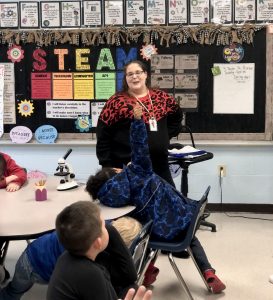East Side Elementary Teacher of the Year – Rachel Winberry
Each year, teachers at every campus in Haywood County Schools cast their vote for who they believe should be Teacher of the Year (TOY) in their respective building. It is an honor that is reflective of the work that has been done in and out of the classroom by teachers who are passionate about students in Haywood County. What makes this recognition even more special, however, is that whoever wins TOY won because their peers recognized the talent and value the person brought to their school.
Rachel Winberry considers herself lucky. Not because she’s living her childhood dream of being a teacher. Not because she gets to teach the coolest class at East Side (STEAM). She acknowledges that those are perks of her job, but she counts herself lucky because as an elective teacher, Rachel gets to teach EVERY student at East Side.
“I feel that I’m called to be here – to be at East Side and in Haywood County. There’s a reason why I’m here. I LOVE my students,” she said. “Being able to teach every single student in the entire school is such a blessing. I love seeing the mix of strengths and talents in all my students. Seeing kids being able to attack a problem and solve it with me being a facilitator is such a privilege.”
Rachel is a veteran teacher, but only recently transitioned to her role as STEAM teacher at East Side.
Like most things in the world of education, STEAM is an acronym – Science, Technology, Engineering, Arts, and Math. With growing job opportunities in Haywood County over the next decade, the foundational skills of STEAM are vital to a student population who will have a myriad of professional possibilities awaiting them upon graduation.
In her class, Rachel recognizes the role that mistakes play in the process of creating something. Her class is arranged in a way that is conducive to student collaboration – something that enhances social skills and problem solving. There’s noise in her class; an excitement that is palpable when you walk in the room.
“The students loved our airplane designs. They got to design an airplane from certain materials and then we flew them. We measured how far they flew, how fast they flew. We worked our Math in there with the distance and speed,” Rachel explained.
An important part of the design process in STEAM is making mistakes. Traditionally, making mistakes is something that could be frowned upon in class, but in truth it’s really the only way to learn anything new.
 Rachel recognizes the importance of helping her students understand that making mistakes is all part of the learning process.
Rachel recognizes the importance of helping her students understand that making mistakes is all part of the learning process.
“One of the biggest things I teach with the engineering and design process in STEAM is that making mistakes is part of the process. So many inventions came to be because of a mistake. On the flip side, trial and error is also part of the creative process. Students have to be free to make mistakes in order to learn,” she said.
Students in elementary school aren’t naturally prone to understanding that making mistakes is part of the process of learning. Students at this age want stickers and smiley faces at the tops of their pages. Creating a safe environment for making mistakes, however, can be more valuable than colorful stickers or a big 100 on a worksheet.
“Students need to feel safe in their learning environment and not just from a physical standpoint. Kids need to feel emotionally safe and be able to make mistakes and learn from those mistakes,” Rachel said. “When I was growing up, I was a bit of a perfectionist, so when I see students who really struggle with making mistakes, I try to remind them that it’s part of the process. I know what it feels like because I was a student who didn’t want to make mistakes. A famous quote I always repeat is ‘We haven’t failed, we just found a way that didn’t work.’”
And, that is just a glimpse into what makes Rachel a wonderful educator.
Along with creating a space for creativity and growth in a subject where both are necessary, Rachel also leans into personal qualities that make her a successful teacher.
“I think patience is a very important trait for a teacher, but a teacher’s enthusiasm is probably the most important trait to me. If a teacher is excited about their subject, the kids will be excited, too,” she said. “I want my students to feel my excitement. When I was in college, one of my professors said something that I won’t forget. He said, ‘If you’re going to go into teaching, don’t apologize. Don’t apologize to the kids for what you’re about to teach them. Be excited for what you’re about to teach them.’”
Rachel’s class is full of excitement and not just because students are building airplanes or studying specimens under a microscope for the first time. Students are excited because Rachel’s enthusiasm is contagious. Beyond that enthusiasm, though, is a bedrock foundation of all successful teachers: relationships with the students.
“Building relationships with students is everything. If a student knows you’re in their corner and are their biggest champion, the learning will come. This is especially true for students who may not have a mentoring figure in their life,” she said.
The intangible aspects of teaching are often the most important – building relationships, creating safe environments. However, what separates the good teachers from the great teachers is when a teacher can combine the intangible skills with great instruction.
“I have been told on several evaluations that I ask very thought provoking questions,” Rachel said. “I think questioning students is such an important part of learning. It helps to know if they understand the lesson or allows them to expound and dive deeper into something.”
As Rachel continues to guide students through the process of creating and designing (and the process of making mistakes), she hopes that she can be an influence on them much the same way her fourth grade teacher was an influence on her.
“I think teaching is a calling. My personal journey started when I was ten years old,” she reflected. ”My fourth grade teacher was so patient with me and dedicated to helping me learn and that really shaped my desire to teach at an early age.”
In the end, like all teachers, Rachel wants to have a lasting impact on her students.
“Hopefully, something I teach them or tell them, they’ll be able to carry with them long after they’ve left my classroom.”


